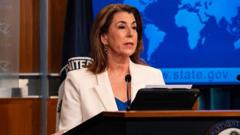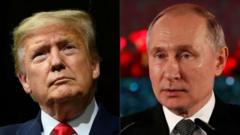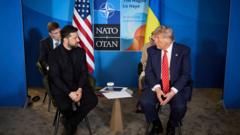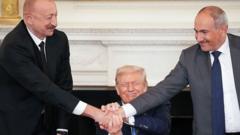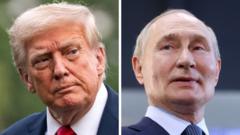Mark Rutte's ambitious plan seeks to secure Trump’s approval while enhancing Europe's defense capabilities amid ongoing geopolitical tensions.
**NATO Eyes Defense Spending Hike to 5% of GDP Under Rutte's Plan**

**NATO Eyes Defense Spending Hike to 5% of GDP Under Rutte's Plan**
NATO Secretary General's new defense spending proposal aims to strengthen transatlantic relations ahead of the upcoming summit.
According to sources, NATO's Secretary General Mark Rutte is looking to ensure that previous tensions with the United States regarding defense spending do not resurface at the upcoming summit. Rutte is poised to propose that NATO members allocate 5% of their gross domestic product (GDP) to defense spending—a substantial increase from the current 2% target, which has often drawn criticism from former President Donald Trump.
The call for increased defense expenditures is likely to resonate with Trump, who has consistently argued that European allies do not contribute enough to their own security and instead lean heavily on U.S. defense resources. At a recent press conference in Brussels, Rutte emphasized the need for a stronger commitment from alliance members, which will likely raise questions about the strategic intent behind such a notable spending increase—whether it is primarily aimed at counteracting Russia's influence or aimed at placating the demands of the U.S. leader.
As per discussions, Rutte's proposal introduces a compromise approach that divides the 5% target into two parts: a mandatory 3.5% allocated strictly for core defense spending, while the remaining 1.5% can be directed towards "defense-related expenditures." This broader definition allows more flexibility for individual nations in how they meet their obligations, potentially including spending on infrastructure and industry enhancements.
Rutte also stated that the U.S. would adhere to the new defense spending target, though for Washington, which already spends around 3.4% of its GDP on defense, it may represent a moderate shift. Nonetheless, the practicality of achieving these funding levels remains an open question—especially considering that some nations are still struggling to meet the previously set 2% target from a decade ago.
At the press conference, Rutte, who previously managed a country that hasn't hit the 2% mark, acknowledged the challenge of holding nations accountable over time. To address this, he mentioned having developed a "cunning plan" that would require leaders to submit yearly spending plans to ensure consistent progress towards the new 5% target, preventing a sudden spike in defense budgets as deadlines approach.
Rutte is scheduled to meet UK Prime Minister Sir Keir Starmer next week, where discussions regarding the UK’s defense spending—which currently aims for 2.5% by 2027—will likely be on the agenda. U.S. Defense Secretary Pete Hegseth indicated that several countries, including France, Germany, and several Eastern European nations, have already committed to the 5% pledge but did not disclose which countries remain noncommittal. Nevertheless, he expressed confidence that nations like the UK would ultimately rise to meet the challenge.
In conclusion, the NATO summit in The Hague will serve as a critical juncture for transatlantic defense strategies, with Rutte’s comprehensive spending plan aiming to reshape the funding landscape amid growing geopolitical pressures.
The call for increased defense expenditures is likely to resonate with Trump, who has consistently argued that European allies do not contribute enough to their own security and instead lean heavily on U.S. defense resources. At a recent press conference in Brussels, Rutte emphasized the need for a stronger commitment from alliance members, which will likely raise questions about the strategic intent behind such a notable spending increase—whether it is primarily aimed at counteracting Russia's influence or aimed at placating the demands of the U.S. leader.
As per discussions, Rutte's proposal introduces a compromise approach that divides the 5% target into two parts: a mandatory 3.5% allocated strictly for core defense spending, while the remaining 1.5% can be directed towards "defense-related expenditures." This broader definition allows more flexibility for individual nations in how they meet their obligations, potentially including spending on infrastructure and industry enhancements.
Rutte also stated that the U.S. would adhere to the new defense spending target, though for Washington, which already spends around 3.4% of its GDP on defense, it may represent a moderate shift. Nonetheless, the practicality of achieving these funding levels remains an open question—especially considering that some nations are still struggling to meet the previously set 2% target from a decade ago.
At the press conference, Rutte, who previously managed a country that hasn't hit the 2% mark, acknowledged the challenge of holding nations accountable over time. To address this, he mentioned having developed a "cunning plan" that would require leaders to submit yearly spending plans to ensure consistent progress towards the new 5% target, preventing a sudden spike in defense budgets as deadlines approach.
Rutte is scheduled to meet UK Prime Minister Sir Keir Starmer next week, where discussions regarding the UK’s defense spending—which currently aims for 2.5% by 2027—will likely be on the agenda. U.S. Defense Secretary Pete Hegseth indicated that several countries, including France, Germany, and several Eastern European nations, have already committed to the 5% pledge but did not disclose which countries remain noncommittal. Nevertheless, he expressed confidence that nations like the UK would ultimately rise to meet the challenge.
In conclusion, the NATO summit in The Hague will serve as a critical juncture for transatlantic defense strategies, with Rutte’s comprehensive spending plan aiming to reshape the funding landscape amid growing geopolitical pressures.





